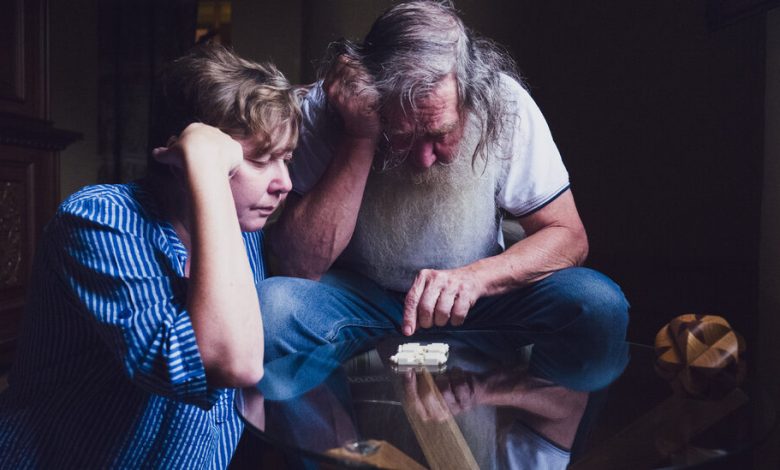Need a Home for 80,000 Puzzles? Try an Italian Castle.

Meet the Millers, George and Roxanne, proprietors of the world’s largest collection of mechanical puzzles: physical objects that a puzzler holds and manipulates while seeking a solution. In total, the Miller collection — an accumulation of collections, and collections of collections — amounts to more than 80,000 puzzles. It comprises some five thousand Rubik’s Cubes, including a 2-by-2-by-2 rendering of Darth Vader’s head. And there are more than 7,000 wooden burr puzzles, such as the interlocking, polyhedral creations by Stewart Coffin, a Massachusetts puzzle maker; they evoke a hybrid of a pine cone and a snowflake and are Mr. Miller’s favorites. Mrs. Miller is fond of their 140 brass, bronze and gold puzzle sculptures by the Spanish artist Miguel Berrocal; Goliath, a male torso in 79 pieces, is “a puzzle that all puzzlers lust after,” she said.
Until recently, the Miller collection resided at Puzzle Palace in Boca Raton, Fla., filling their mansion and a museum (a smaller house) next door. Puzzles occupied even the bathrooms. Then last year, on a whim, the Millers bought a 15th-century, 52-room castle in Panicale, a hamlet in central Italy. They packed their puzzle collection into five 40-foot shipping containers and, for their own transit, booked a cruise from Miami to Rome.
Before sailing away in April, the Millers went on a two-month road trip — “a last hurrah,” Mr. Miller called it — visiting puzzler friends from coast to coast. Along the way they accumulated more puzzles. In Garden Grove, Calif., they loaded up a cargo van with 58 boxes from Marti Reis, who donated her collection of folksy punning puzzles by the designer RGee Watkins, such as Diamond Ring, a dime with a metal ring passing through the coin’s center. The puzzle maker Lee Krasnow, who has production facilities in Portland, Ore., and Grand Rapids, Mich., met the Millers at a puzzle party on the outskirts of Austin, Texas, and hand-delivered his famed Clutch Box. Made from exotic hardwoods and precision machined metals, it opens with a subtle unlocking mechanism; the goal is simply “the thrill of having opened it,” Mrs. Miller said. And then, “if you’re daring,” Mr. Krasnow added in an email, the goal is “to fully disassemble it into about 40 individual pieces.”




Before moving to Italy, the Millers traveled across the United States to acquire puzzles, including Lee Krasnow’s famed clutch box, upper right, and a puzzle version of their Florida home, lower left, made by Tracy Wood Clemons Batz, lower right, of Scottsville, N.Y.Credit…Lauren Petracca for The New York Times
For the Millers, nothing compared with the thrill of finally getting their hands on the second version of Mega Mansion, their Florida abode miniaturized as a sequential discovery box. Mrs. Miller commissioned this creation in February 2020 from Tracy Wood Clemons Batz, a puzzle artist in Scottsville, N.Y.; the original construction was irreparably damaged in an ordeal with the courier company. The box opens as the puzzler finds 14 hidden keys and tools that unlock four tiers of discovery in 130 steps.
“I hate solving puzzles, I don’t enjoy it at all,” Mrs. Clemons Batz said in a Zoom interview. “I enjoy stumping people.”
Driven by difficulty
Puzzleland is populated by self-described zealots. For instance, Bret Rothstein, a historian of “visual and material cultures of play” at Indiana University Bloomington, is the author of a book about puzzles, “The Shape of Difficulty: A Fan Letter to Unruly Objects.” Therein, Dr. Rothstein observes that Thomas Kuhn, a historian and philosopher of science, aligned puzzling with scientific inquiry. Puzzles force us to embrace error, Dr. Rothstein notes, adding that perhaps their most beautiful feature is their “continual erosion of certitude.”



The Millers’s 52-room castle in Panicale, central Italy. They packed their puzzle collection into five 40-foot shipping containers and, for their own transit, booked a cruise from Miami to Rome.Credit…Clara Vannucci for The New York Times
Another term for a puzzles zealot is “aspirant.” “We aspire to solve them,” Dr. Rothstein said in an interview. “And when we’ve solved one, we’re ready for the next.” Most puzzlers are difficulty-driven, he said. “We’re looking for more obstacles.” Case in point, the Millers: Dr. Rothstein found their Florida-to-Italy odyssey at once “exciting” and “daunting.”
“We run into problems, we solve the problems, that’s what puzzling is all about,” Mr. Miller said. When their collection is reopened — circa January 2025 — it will be under the name “World Puzzle Center,” reflecting their bigger dream: not only a museum, but a place for parties and lectures, competitions and research; a space to design, make and play with puzzles.
By the time their 108 pallets of puzzles started arriving in December, the Millers had settled in at Castello di Panicale and among their new community. Mr. Miller, who sports a long white beard, was asked to be the village Santa Claus; over one weekend, 200 local school children came for Christmas visits at the castle.
They had made a decent start setting up the center, furnishing rooms with Rococo display cabinets and organizing recently acquired collections that arrived directly from England, France, Finland, Germany and the Netherlands. Some of the newest additions to their collection are from an August excursion to the International Puzzle Party, an annual invitation-only event, held this year in Jerusalem.
The first such party convened in 1978, with 10 people in the Beverly Hills living room of Jerry Slocum, a puzzle collector who has taken a scholarly approach, writing numerous books on puzzle history and developing a classification system. He accumulated a collection of some 40,000 puzzles, most of which he donated to the Lilly Library at Indiana University Bloomington. Of the Miller collection, Mr. Slocum said, “It’s big.”



The Millers hope to open their collection to the public in 2025 under the name World Puzzle Center, as not only a museum but a place for parties, lectures, competitions, research and play.Credit…Clara Vannucci for The New York Times
Pivotal prototyping
The Millers met at the International Puzzle Party in 2010, married in 2018 (after parallel divorces) and melded their collections. She came to the marriage with about 20,000 puzzles; he had a couple thousand.
Mrs. Miller, 56, got her first puzzle at age 6 — “I never stopped playing with them,” she said. By 1993, having studied history and applied linguistics, she landed in Hong Kong and worked as a teacher. She also volunteered at toys and games fairs — where she got to know puzzle manufacturers and really started collecting.
Mr. Miller, 78, began puzzling later in life. After a stint in the circus (juggling, high trapeze), he studied artificial intelligence and then spent his career at Bank of America, designing foreign-exchange systems. When he retired in 1997, at 52, his enthusiasm for puzzles took an earnest turn: He became the first dedicated puzzle prototyper. He bought a laser cutter, and later a 3-D printer (for $37,000 at the time), and made his fellow puzzlers an offer: Anyone could send a design, and he would produce a prototype for free; in exchange, he would keep one copy for himself. (He also produced his own designs and sold these puzzles on his website, the original Puzzle Palace.)
“George was pivotal,” Oskar van Deventer, a prolific Dutch puzzle designer, said in an interview; the prototyping offer triggered a transformation in puzzle making. “George helped people, like myself, to make a first, functional prototype that I could present to producers like Hanayama,” Dr. van Deventer said. “Until George’s free public offer, prototyping needed to be done by the inventor.”
Mr. Miller saw a shift from a competitive environment, with designers protecting their inventions, to a more cooperative spirit. After he gave Dr. van Deventer a laptop with CAD software installed, a deluge of designs began arriving by email. Mr. Miller would set up the printer (located for a time in his bedroom closet), let it run overnight and then wake to a new puzzle, “just like Christmas,” Mr. Miller said; he named this machine Santa Claus. The pair produced several dozen puzzles together — Oskar’s Exotics, Mr. Miller called them, and thus he began his collection.
Fast forward to 2021: The Millers acquired the 40,000-puzzle Hordern-Dalgety collection in Britain (previously two collections by Edward Hordern and James Dalgety; Mr. Hordern had amalgamated the collections of Edith Constance Jardine Senior and Eileen Scott, among others). “You can see why we had to buy a castle,” Mr. Miller told the computer scientist Donald Knuth during the couple’s visit to his house in Stanford, Calif.




The Millers have begun setting up the center, furnishing rooms with Rococo display cabinets and organizing collections arriving from England, France, Finland, Germany and the Netherlands. Some of the newest additions come from an August trip to the International Puzzle Party, an annual invitation-only event held this year in Jerusalem.Credit…Clara Vannucci for The New York Times
Loony entanglements
Over the years, Dr. Knuth and Mr. Miller have collaborated on a handful of puzzles, “taking a difficult mathematical problem and solving it and then working out a mechanical analog,” as Mr. Miller described the process. Their most successful collaboration was Cubigami 7: The goal is to fold 18 interlocking plastic squares into seven arrangements of four cubes, or “tetracubes.” Mr. Miller had casually mentioned the idea at a puzzle party. “I stayed up all night working on it,” Dr. Knuth said.
As they chatted, he opened a cupboard, jampacked with puzzles. “I keep them all hidden because I don’t know how to put them back together again,” Dr. Knuth said. He pulled out a puzzle named Loony Loop.
“Oh yeah, I’ve got that,” Mrs. Miller said of this disentanglement puzzle: a loop of red cord tangled among four loops of metal.
“I’ve got, I think, the best explanation of the Loony Loop,” Dr. Knuth said, referencing his book “The Art of Computer Programming,” Volume 4A, on combinatorial algorithms. Dr. Knuth later explained that he was interested in puzzles as an educational resource: “I don’t just present an algorithm out of the blue. I say, ‘What’s it good for?’” An algorithm is often good for solving a puzzle’s underlying mathematical problem: In contemplating a puzzle, “the point of an algorithm becomes clear,” he said.
The information sheet in the Loony Loop box noted that this puzzle was “scientifically engineered” and that freeing the red cord required “only eight loony moves.” It added: “What would life be without a challenge? Don’t give up! It can be done. Think!”
Another disentanglement puzzle in the Miller collection is The Lovers — a life-size replica of the couple, nude, cast in bronze, with a loop of rope entangled around their topologically puzzling embrace. (The puzzle is also the focal point of “The Puzzle Palace,” a documentary film about the Millers by Jenny Schweitzer Bell and Brian Bell, slated to make its world premiere at a film festival in 2024.)
Mrs. Miller had gotten a “wild hair,” she said. “I wanted a puzzle of us.” “That’s our favorite puzzle, and no one else has it,” Mr. Miller said.
Mrs. Miller said, “No one else would want it, right?”
“It’s one of a kind,” he said.

Credit…Clara Vannucci for The New York Times



